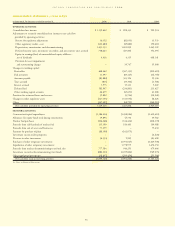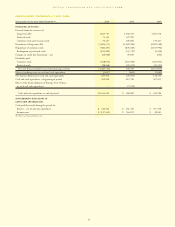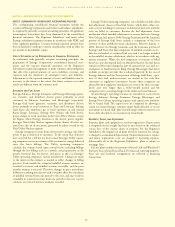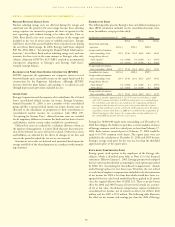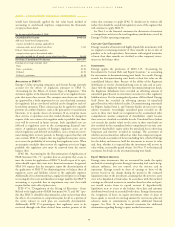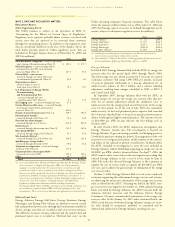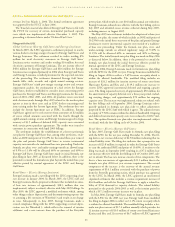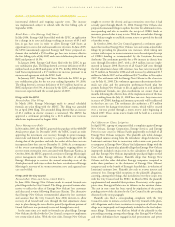Entergy 2006 Annual Report Download - page 75
Download and view the complete annual report
Please find page 75 of the 2006 Entergy annual report below. You can navigate through the pages in the report by either clicking on the pages listed below, or by using the keyword search tool below to find specific information within the annual report.
ENTERGY CORPORATION AND SUBSIDIARIES 2
2000066
would have historically applied the fair value based method of
accounting to stock-based employee compensation (in thousands,
except per share data):
For the year ended December 31, 2004
Consolidated Net Income $909,524
Add back: Stock-based compensation
expense included in earnings applicable to
common stock, net of related tax effects 5,141
Deduct: Total stock-based employee
compensation expense determined under
fair value method for all awards, net of related tax effects 16,668
Pro Forma Consolidated Net Income $897,997
Earnings per average common share:
Basic $4.01
Basic – pro forma $3.96
Diluted $3.93
Diluted – pro forma $3.88
APPLICATION OF SFAS 71
Entergy’s Utility operating companies and System Energy currently
account for the effects of regulation pursuant to SFAS 71,
“Accounting for the Effects of Certain Types of Regulation.” This
statement applies to the financial statements of a rate-regulated enter-
prise that meets three criteria. The enterprise must have rates that (i)
are approved by a body empowered to set rates that bind customers
(its regulator); (ii) are cost-based; and (iii) can be charged to and col-
lected from customers. These criteria may also be applied to separable
portions of a utility’s business, such as the generation or transmission
functions, or to specific classes of customers. If an enterprise meets
these criteria, it capitalizes costs that would otherwise be charged to
expense if the rate actions of its regulator make it probable that those
costs will be recovered in future revenue. Such capitalized costs are
reflected as regulatory assets in the accompanying financial state-
ments. A significant majority of Entergy’s regulatory assets, net of
related regulatory and deferred tax liabilities, earn a return on invest-
ment during their recovery periods, or Entergy expects that they will
earn a return. SFAS 71 requires that rate-regulated enterprises contin-
ue to assess the probability of recovering their regulatory assets. When
an enterprise concludes that recovery of a regulatory asset is no longer
probable, the regulatory asset must be removed from the entity’s
balance sheet.
SFAS 101, “Accounting for the Discontinuation of Application of
FASB Statement No. 71,” specifies how an enterprise that ceases to
meet the criteria for application of SFAS 71 for all or part of its oper-
ations should report that event in its financial statements. In general,
SFAS 101 requires that the enterprise report the discontinuation of
the application of SFAS 71 by eliminating from its balance sheet all
regulatory assets and liabilities related to the applicable segment.
Additionally, if it is determined that a regulated enterprise is no longer
recovering all of its costs and therefore no longer qualifies for SFAS 71
accounting, it is possible that an impairment may exist that could
require further write-offs of plant assets.
EITF 97-4: “Deregulation of the Pricing of Electricity - Issues
Related to the Application of FASB Statements No. 71 and 101” spec-
ifies that SFAS 71 should be discontinued at a date no later than when
the effects of a transition to competition plan for all or a portion of
the entity subject to such plan are reasonably determinable.
Additionally, EITF 97-4 promulgates that regulatory assets to be
recovered through cash flows derived from another portion of the
entity that continues to apply SFAS 71 should not be written off;
rather, they should be considered regulatory assets of the segment that
will continue to apply SFAS 71.
See Note 2 to the financial statements for discussion of transition
to competition activity in the retail regulatory jurisdictions served by
Entergy’s Utility operating companies.
CASH AND CASH EQUIVALENTS
Entergy considers all unrestricted highly liquid debt instruments with
an original or remaining maturity of three months or less at date of
purchase to be cash equivalents. Investments with original maturities
of more than three months are classified as other temporary invest-
ments on the balance sheet.
INVESTMENTS
Entergy applies the provisions of SFAS 115, “Accounting for
Investments for Certain Debt and Equity Securities,” in accounting
for investments in decommissioning trust funds. As a result, Entergy
records the decommissioning trust funds at their fair value on the
consolidated balance sheet. Because of the ability of the Registrant
Subsidiaries to recover decommissioning costs in rates and in accor-
dance with the regulatory treatment for decommissioning trust funds,
the Registrant Subsidiaries have recorded an offsetting amount of
unrealized gains/(losses) on investment securities in other regulatory
liabilities/assets. For the nonregulated portion of River Bend, Entergy
Gulf States has recorded an offsetting amount of unrealized
gains/(losses) in other deferred credits. Decommissioning trust funds
for Pilgrim, Indian Point 2, and Vermont Yankee do not receive reg-
ulatory treatment. Accordingly, unrealized gains recorded on the
assets in these trust funds are recognized in the accumulated other
comprehensive income component of shareholders’ equity because
these assets are classified as available for sale. Unrealized losses (where
cost exceeds fair market value) on the assets in these trust funds are
also recorded in the accumulated other comprehensive income com-
ponent of shareholders’ equity unless the unrealized loss is other than
temporary and therefore recorded in earnings. The assessment of
whether an investment has suffered an other than temporary impair-
ment is based on a number of factors including, first, whether Entergy
has the ability and intent to hold the investment to recover its value
and, then, whether it is expected that the investment will recover its
value within a reasonable period of time. See Note 17 to the financial
statements for details on the decommissioning trust funds.
EQUITY METHOD INVESTEES
Entergy owns investments that are accounted for under the equity
method of accounting because Entergy’s ownership level results in sig-
nificant influence, but not control, over the investee and its
operations. Entergy records its share of earnings or losses of the
investee based on the change during the period in the estimated
liquidation value of the investment, assuming that the investee’s assets
were to be liquidated at book value. In accordance with this method,
earnings are allocated to owners or members based on what each part-
ner would receive from its capital account if, hypothetically,
liquidation were to occur at the balance sheet date and amounts
distributed were based on recorded book values. Entergy discontinues
the recognition of losses on equity investments when its share of
losses equals or exceeds its carrying amount for an investee plus any
advances made or commitments to provide additional financial
support. See Note 14 to the financial statements for additional
information regarding Entergy’s equity method investments.
NOTESto CONSOLIDATED FINANCIAL STATEMENTS continued
59







